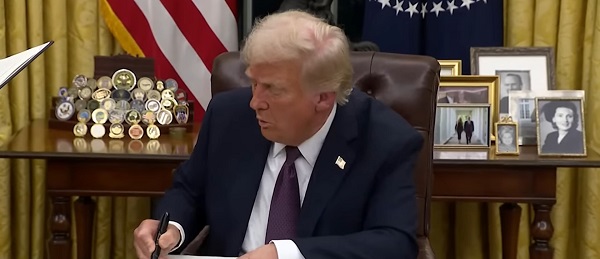Business
Understanding the Nature of Canada’s Fiscal and Economic Challenges

From the Fraser Institute
By Jake Fuss and Jason Clemens
” between 2016 and 2019 (pre-COVID), growth in per-person GDP (inflation-adjusted) was an anemic 0.9 percent. According to one study, among the last five pre-recession periods in Canadian history, the Trudeau period (again, 2016 to 2019) recorded the weakest economic growth “
The Trudeau government was first elected in 2015 based in part on a new approach to government policy, which promised greater prosperity for Canadians based on short-term deficit spending (totaling $25.1 billion over three years), lower taxes for most Canadians (except higher-income earners), and a more active approach to economic development (LPC, 2015). This new policy direction stood in stark contrast to the consensus of the previous 20 years (Clemens and Palacios, 2017). The result has been a marked deterioration in the country’s finances, economic stagnation, and a collapse in business investment. If Canada is to restore its fiscal and economic health, Ottawa must enact fundamental policy reform.
Government spending, taxes, and debt
The Trudeau government has markedly increased spending to finance both new programs and increases in existing programs. Federal spending (excluding interest costs) increased from $256.3 billion in 2014-15 (the year before the Trudeau government took office) to $448.2 billion in 2022-23 (an increase of 74.9 percent) (Canada, 2023a) and a projected $453.0 billion in 2023-24 (Canada, 2023b). Not surprisingly, COVID-related spending contributed to increases in 2019-20 to 2021-22. But in 2022-23 and thereafter, there is no COVID-related spending.
The federal government has used tax increases and large increases in borrowing to finance these spending increases. In 2016, the federal government increased the top personal income tax rate imposed on entrepreneurs, professionals , and business owners from 29 percent to 33 percent. Consequently, the combined top personal income tax rate (federal and provincial) now exceeds 50 percent in eight provinces (with the remaining provinces only slightly below 50 percent) and in 2022 Canada had the 5th highest tax rate out of 38 OECD countries. This represents a serious competitive challenge for Canada’s ability to attract and retain entrepreneurs, investors, skilled professionals, and businesses.
And while the Trudeau government reduced the middle personal income tax rate, it also eliminated several tax credits. The combination of the two policy changes means that 86 percent of middle-income families now pay higher personal income taxes (Palacios et al., 2022). If the analysis also includes increases to the Canada Pension Plan contribution rate, almost all Canadians now pay higher taxes.

The Trudeau government also borrowed to finance its new spending. Figure 1 contrasts the originally
planned deficits with the actual deficits incurred by the Trudeau government (excluding COVID-related
spending) from 2016-17 to 2022-23. The actual borrowing exceeds the originally planned borrowing
every year (except 2021-22), often by significant margins, due to the government’s inability to control
spending growth.
The string of deficits means federal debt (measured as gross debt) has ballooned to $1.9 trillion
(2022-23) and is projected to reach $2.4 trillion by 2027/28, fueling a dramatic growth in interest costs,
which have grown by 53.2 percent (inflation-adjusted) between 2014/15 and 2023/24 and will reach
a projected $46.5 billion in 2023/24. Interest costs now consume substantial revenue that is then unavailable for government services or tax reduction.
Simply put, Trudeau government policy changes have produced large increases in government spending, taxes, and borrowing. Unfortunately, these policy changes have not resulted in a more robust and vibrant economy.
Weak economic growth and collapsing business investment
The broadest measure of living standards is GDP per person, which calculates the total value of all goods and services produced in the economy in a given year (adjusted by the population). As illustrated in Figure 2, between 2016 and 2019 (pre-COVID), growth in per-person GDP (inflation-adjusted) was an anemic 0.9 percent. According to one study, among the last five pre-recession periods in Canadian history, the Trudeau period (again, 2016 to 2019) recorded the weakest economic growth (Clemens, Palacios, and Veldhuis, 2021). Another study found that Canada’s per-person GDP growth from 2013 to 2022 was the weakest on record since the 1930s (Cross, 2023). And per-person GDP in 2022 (inflation-adjusted) had still not recovered from the pandemic losses and was basically stagnant at 2018 levels (see figure 2).
Prospects for the future, given current policies, are not encouraging. The OECD projects that Canada will record the lowest rate of per-person GDP growth among 32 advanced economies from 2020 to 2030 and from 2030 to 2060(OECD, 2021).Countries such as Estonia, South Korea, and New Zealand are expected to vault past Canada and achieve higher living standards by 2060.

According to a recent analysis, Canada’s economic growth crisis is due in part to the decline in business investment, which is critical to increasing living standards because it equips workers with tools and technologies to produce more higher-quality goods and services. This, in turn, fuels innovation and improved productivity (Cross, 2023). There are obvious explanations for the decline in business investment including regulatory barriers, particularly related to the energy and mining sectors (Globerman and Emes, 2021), and government deficits, which imply tax increases in the future, dampening investment today. Business investment (inflation-adjusted), excluding residential construction, has declined by 1.8 percent annually since 2014.
According to a 2023 study (Hill and Emes, 2023), between 2014 and 2021, business investment per worker (inflation-adjusted, excluding residential construction) decreased by $3,676 (to $14,687) compared to growth of $3,418 (to $26,751) in the United States. Put differently, in 2014, Canadian
businesses invested 79 cents per worker for every dollar invested in the United States. By 2021, that level of investment had declined to just 55 cents per worker.
Moreover, the amount of investment in Canada by foreigners has decreased while the amount of investment by Canadians outside of the country has increased. In 2008, the two levels were roughly comparable—$65.7 billion in foreign direct investment (FDI) in Canada vs. $84.6 billion in investment by Canadians outside of the country. However, a sizeable change began in 2015; by 2022, the amount of FDI ($64.6 billion) was significantly smaller than the amount of investment by Canadians outside the country ($102.3 billion).
Finally, while Canada’s labour market has consistently demonstrated its strength and resilience, the labour market numbers hide some concerning trends. For example, between February 2020 (when the pandemic began) and June 2023, private-sector job creation (net) was fairly weak at 3.3 percent compared to 11.8 percent job growth in the government sector (Eisen, Ryan and Palacios, 2023). In other words, the recovery and growth in the private sector following the pandemic has not been as strong as expected.
Conclusion: The Path Forward
There is reason for optimism, however, since many of Canada’s challenges are of the federal government’s own making. The Chrétien Liberals in the 1990s faced many of the same challenges that we do today (Veldhuis, Clemens, and Palacios, 2011). By shifting the focus to more prudent government spending, balanced budgets, debt reduction, and competitive tax rates, the Chrétien Liberals—followed in large measure by the Harper Tories—paved the way for two decades of prosperity when Canada outperformed other OECD countries on economic growth, job-creation, and business investment.
To help foster greater prosperity for Canadians today, the federal government can learn from the Chrétien Liberals, and the Harper Tories. The rest of this series identifies policy options that can increase living standards for Canadians by repairing federal finances, improving tax competitiveness, and lowering economic barriers. These reforms could help build a more prosperous country through the creation of good jobs which would lead to rising incomes for Canadians.
Authors:
Alberta
COWBOY UP! Pierre Poilievre Promises to Fight for Oil and Gas, a Stronger Military and the Interests of Western Canada

Fr0m Energy Now
As Calgarians take a break from the incessant news of tariff threat deadlines and global economic challenges to celebrate the annual Stampede, Conservative party leader Pierre Poilievre gave them even more to celebrate.
Poilievre returned to Calgary, his hometown, to outline his plan to amplify the legitimate demands of Western Canada and not only fight for oil and gas, but also fight for the interests of farmers, for low taxes, for decentralization, a stronger military and a smaller federal government.
Speaking at the annual Conservative party BBQ at Heritage Park in Calgary (a place Poilievre often visited on school trips growing up), he was reminded of the challenges his family experienced during the years when Trudeau senior was Prime Minister and the disastrous effect of his economic policies.
“I was born in ’79,” Poilievre said. “and only a few years later, Pierre Elliott Trudeau would attack our province with the National Energy Program. There are still a few that remember it. At the same time, he hammered the entire country with money printing deficits that gave us the worst inflation and interest rates in our history. Our family actually lost our home, and we had to scrimp and save and get help from extended family in order to get our little place in Shaughnessy, which my mother still lives in.”
This very personal story resonated with many in the crowd who are now experiencing an affordability crisis that leaves families struggling and young adults unable to afford their first house or condo. Poilievre said that the experience was a powerful motivator for his entry into politics. He wasted no time in proposing a solution – build alliances with other provinces with mutual interests, and he emphasized the importance of advocating for provincial needs.
“Let’s build an alliance with British Columbians who want to ship liquefied natural gas out of the Pacific Coast to Asia, and with Saskatchewanians, Newfoundlanders and Labradorians who want to develop their oil and gas and aren’t interested in having anyone in Ottawa cap how much they can produce. Let’s build alliances with Manitobans who want to ship oil in the port of Churchill… with Quebec and other provinces that want to decentralize our country and get Ottawa out of our business so that provinces and people can make their own decisions.”
Poilievre heavily criticized the federal government’s spending and policies of the last decade, including the increase in government costs, and he highlighted the negative impact of those policies on economic stability and warned of the dangers of high inflation and debt. He advocated strongly for a free-market economy, advocating for less government intervention, where businesses compete to impress customers rather than impress politicians. He also addressed the decade-long practice of blocking and then subsidizing certain industries. Poilievre referred to a famous quote from Ronald Reagan as the modus operandi of the current federal regime.
“The Government’s view of the economy could be summed up in a few short phrases. If anything moves, tax it. If it keeps moving, regulate it. And if it stops moving, subsidize it.”
The practice of blocking and then subsidizing is merely a ploy to grab power, according to Poilievre, making industry far too reliant on government control.
“By blocking you from doing something and then making you ask the government to help you do it, it makes you reliant. It puts them at the center of all power, and that is their mission…a full government takeover of our economy. There’s a core difference between an economy controlled by the government and one controlled by the free market. Businesses have to clamour to please politicians and bureaucrats. In a free market (which we favour), businesses clamour to impress customers. The idea is to put people in charge of their economic lives by letting them have free exchange of work for wages, product for payment and investment for interest.”
Poilievre also said he plans to oppose any ban on gas-powered vehicles, saying, “You should be in the driver’s seat and have the freedom to decide.” This is in reference to the Trudeau-era plan to ban the sale of gas-powered cars by 2035, which the Carney government has said they have no intention to change, even though automakers are indicating that the targets cannot be met. He also intends to oppose the Industrial Carbon tax, Bill C-69 the Impact Assessment Act, Bill C-48 the Oil tanker ban, the proposed emissions cap which will cap energy production, as well as the single-use plastics ban and Bill C-11, also known as the Online Streaming Act and the proposed “Online Harms Act,” also known as Bill C-63. Poilievre closed with rallying thoughts that had a distinctive Western flavour.
“Fighting for these values is never easy. Change, as we’ve seen, is not easy. Nothing worth doing is easy… Making Alberta was hard. Making Canada, the country we love, was even harder. But we don’t back down, and we don’t run away. When things get hard, we dust ourselves off, we get back in the saddle, and we gallop forward to the fight.”
Cowboy up, Mr. Poilievre.
Maureen McCall is an energy professional who writes on issues affecting the energy industry.
Business
Carney’s new agenda faces old Canadian problems

From the Fraser Institute
In his June speech announcing a major buildup of Canada’s military, Prime Minister Mark Carney repeated his belief that this country faces a “hinge moment” of the sort the allied countries confronted after the Second World War.
A better comparison might be with the beginning of the war itself.
Then, the Allies found themselves at war with an autocratic state bent on their defeat and possible destruction. Now, Carney faces an antagonistic American president bent on annexing Canada through economic warfare.
Then, Canada rose to the challenge, creating the world’s third-largest navy and landing an army at Normandy on D-Day. Now, Carney has announced the most aggressive reorienting of Canada’s economic, foreign and defence policies in generations.
Polls show strong support among Canadians for this new agenda. But the old Canada is still there. It will fight back. It may yet win.
The situation certainly would have been more encouraging had Carney not inherited Justin Trudeau’s legacy of severe economic and environmental restrictions—picking economic winners and losers rather than letting the market decide—and chronic deficits. The new prime minister would do well to dismantle as much of that legacy as he can.
Some advocate a return to the more laissez-faire approach of Stephen Harper’s government. But Harper didn’t confront a belligerent president hoping to annex Canada through the “economic force” of tariff walls.
The prime minister succeeded in getting Bill C-5, which is intended to weaken at least some of the restrictions on resource development and infrastructure, passed into law. He and the premiers pledge to finally dismantle generations of internal trade and labour mobility barriers. If we must trade less with the Americans, we can at least learn to trade with ourselves.
And the prime minister deserves high praise for reversing decades of military decline through increased spending and efforts to improve procurement. If Carney accomplishes nothing more than restoring Canada’s defences, especially in the Arctic, he will be well remembered.
That said, major challenges confront the Carney agenda.
There’s much talk about a new national energy corridor. But what does that mean? One KPMG executive defined it as a “dedicated, streamlined pathway for the energy, electricity, decarbonization, transportation and digital infrastructure.”
Yes, but what does that mean?
Whatever it means, some First Nations will oppose it tooth-and-nail. Not all of them, mind you. The First Nations Major Project Coalition is dedicated to assisting First Nations in working with government and the private sector for the benefit of all. But many First Nations people consider resource development further exploitation of their ancestral lands by a colonizing power. At the first major proposal to which they do not buy in, they will take the government to court.
What investor will be willing to commit to a project that could be blocked for years as First Nations and Ottawa fight it out all the way to the Supreme Court?
The prime minister, formerly a fervent advocate of combatting climate change, now talks about developing “conventional energy,” which means oil and gas pipelines. But environmental activists will fiercely oppose those pipelines.
There is so much that could go wrong. Sweep away those internal trade barriers? Some premiers will resist. Accelerate housing development? Some mayors will resist. Expand exports to Europe and Asia? Some businesses and entrepreneurs will say it’s not worth the risk.
As for the massive increase in defence spending, where will the money come from? What will be next year’s deficit? What will be the deficit’s impact on inflation, interest rates and sovereign creditworthiness? The obstacles are high enough to make anyone wonder how much, if any, of the government’s platform will be realized. But other factors are at work as well, factors that were also present in 1939.
To execute his mandate, Carney is surrounding himself with what, back in the Second World War, were called “dollar a year men”—executives who came to Ottawa from the private sector to mobilize the economy for wartime.
In Carney’s case he has brought in Marc-André Blanchard as chief of staff and Michael Sabia as clerk of the privy council. Both are highly experienced in government and the private sector. Both are taking very large pay cuts because, presumably, they understand the gravity of the times and believe in the prime minister’s plans.
Most important, Carney’s agenda has broad support from a public that fears for the country’s future and will have little patience toward any group seeking to block the prime minister’s agenda.
Millions of Canadians want this government’s reform efforts to succeed. Those who would put it at risk of failing will have to contend with public anger. That gives Carney a shot at making real change.
-

 Daily Caller2 days ago
Daily Caller2 days agoTrump’s One Big Beautiful Bill Resets The Energy Policy Playing Field
-

 Alberta8 hours ago
Alberta8 hours agoCOWBOY UP! Pierre Poilievre Promises to Fight for Oil and Gas, a Stronger Military and the Interests of Western Canada
-

 Alberta1 day ago
Alberta1 day agoAlberta Next: Immigration
-

 Business2 days ago
Business2 days agoThe Digital Services Tax Q&A: “It was going to be complicated and messy”
-

 International2 days ago
International2 days agoElon Musk forms America Party after split with Trump
-

 Carbon Tax2 days ago
Carbon Tax2 days agoCanada’s Carbon Tax Is A Disaster For Our Economy And Oil Industry
-

 Disaster2 days ago
Disaster2 days agoTexas flood kills 43 including children at Christian camp
-

 Alberta8 hours ago
Alberta8 hours agoAlberta and Ontario sign agreements to drive oil and gas pipelines, energy corridors, and repeal investment blocking federal policies






